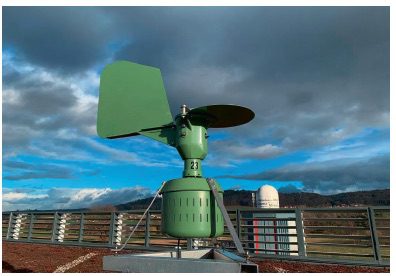14 MEASUREMENT STATIONS
MeteoSwiss, the Federal Office of Meteorology and Climatology operates a nationwide pollen measurement network comprising 14 measurement stations where pollen concentrations in the air are measured. Based on the data and forecasts about the pollen count, sensitive people can limit their exposure and treat their allergy symptoms in a targeted and best possible way. Doctors use this information to diagnose, prevent and plan treatments for allergies. Most pollen traps are located in cities or urban areas because that is where most allergy sufferers live. Each measuring station is equipped with a volumetric pollen trap.
A pump sucks in 10 litres of air per minute, which corresponds to the volume of human respiration. Behind the suction opening, a cylinder rotates, which is covered with a transparent plastic strip coated with silicone, to which the particles present in the sucked-in air stick. Besides pollen, fungal spores, dust, soot and occasionally Sahara dust or volcanic ash stick to it. Traps of this kind are used throughout Europe to measure pollen concentrations in the air.
The cylinder is changed once a week and sent by express courier to the analysis centre in Payerne, where the strip is separated from the cylinder, cut into 7 parts (for the 7 days of the week) and embedded on slides. 27 Subsequently, the individual pollen grains are identified and counted in a detailed analysis under the microscope. If the pollen count is high, it often happens that more than a thousand pollen grains are counted per day. With a simple calculation, these counts can be converted into pollen concentrations per cubic metre of air.
Under the microscope, pollen grains are distinguished according to the size, shape and surface structure of their outer wall. Birch pollen, for example, has three pores and its surface is finely granulated, while ash pollen has a net-like pattern. More than 60 different types of pollen are regularly collected with the traps. Maize pollen, with a diameter of about 100 micrometres, is one of the largest pollen grains and consequently does not fly very far. The most common pollen in the air measures between 20 and 40 micrometres and can be transported several thousand kilometres by the wind. In most cases, however, they fly only a few kilometres.
A new automated network is being set up at MétéoSuisse. Hourly data will be made available in real time for the years 2021-2022. The quality of the forecasts will also be significantly improved.
INFORMATION FOR THE PUBLIC
Based on these measurements and using various models, MeteoSwiss produces pollen forecasts and informs the public via the internet, smartphone applications and traditional media. MeteoSwiss forecasts the beginning of the flowering season and thus the start of the flight of those pollens that trigger the most allergies and provides information on pollen concentrations in the lowlands and at high altitudes and regularly publishes the list of airborne pollens that can cause hay fever symptoms throughout the season. The COSMO-ART dispersion model can be used to calculate pollen concentrations in the different regions of the country and in neighbouring countries. POLLEN
INFORMATION HERE:
General pollen information MeteoSwiss App www.meteoschweiz.ch
App MeteoSwiss Current pollen forecast, pollen measurements and smartphone apps
www.pollenundallergie.ch
Pollen situation in Europe www.polleninfo.org
Aerobiology swiss society www.aerobiologie.ch














0 Comments